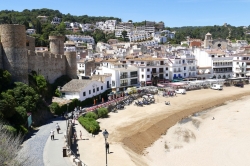COSTA BRAVA
Costa Brava is a great place for the summer holidays. It offers everything you need for pleasant relaxing - excellent weather, beautiful beaches, and bays, pristine nature. Do you want to dedicate time to another pleasure during tours to Costa Brava? Cheerful fiesta and great traditions, historical places and villages, ancient castles and picturesque cities are waiting for you in Costa Brava. The coast got its name thanks to the picturesque rocky cliffs, on the steep slopes of which the Iberian pines and firs grow. Among them, the great view is open to beautiful bays, bays with beaches of white sand and pebbles at the azure sea waves.
Today, the Costa Brava is one of the most popular resorts on the Mediterranean coast of Spain where there are magnificent beaches with areas for outdoor activities and tourism. Resting in the resorts of the Costa Brava, you can successfully combine a beach holiday with a variety of excursions. Moreover, there is really something to see. A number of coastal cities keep echoes of the past - antique villas, castle ruins, ancient monasteries, countless museums. The cultural program is quickly replaced by an entertainment one - in the evening, foamy parties take place on beaches stretching as much as 214 km.
The Costa Brava is the resort in Spain that welcomes millions of tourists from all over the world. The climate is temperate - the average temperature on the coast during the holiday months (May-September) is from 25+ to 30+°C. Thanks to this, tourists can enjoy a lazy beach holiday or walks in picturesque mountainous places with coniferous forests at an optimal, not too hot temperature. The water in the resort area warms up by the end of May and remains warm until September, which means that relaxing on the Costa Brava will delight you with a comfortable swim in a very clean sea for six months.
Many tourists come to Costa Brava for the wild beauty of the beaches and the stunning views of the rocky cliffs, for the soft sand and crystal clear waters of the coast. And it is not in vain that the beaches of the Costa Brava are marked with Blue Flags! The beaches of Costa Brava should undoubtedly be the first on the list of those who are planning family vacations. In most coastal cities, you are offered a wide selection of beaches: from large sandy beaches located close to the center, with all amenities and services, to small bays that are hidden between pine forests and cliffs. They spread from the north of the Alt Empordà region and move down to the southern part of the La Selva region.
Sa Riera is perhaps one of the most famous beaches and bays of the Costa Brava. It is located a short drive from Bagur, a town that is worth a visit for anyone who wants to get to know this region. This place is ideal for families. The landscapes of Aigua Blava, which means "blue water", are similar to images from postcards. The other beaches of Bagur - Sa Tuna, Aiguafred and Playa Fonda - also deserve the attention of tourists.
A distinctive feature of the El Portitxol zone is the proximity of the ancient Greek port of Emporion, an archaeological complex located near the beach. There is a descent for people with disabilities on this stretch of coast. There are many hotels and restaurants in the surrounding area. From Porticola you can get to Las Dunas Avenue, running along the sea between La Escala and the medieval village of San Marti de Empurias. Its length is 2.5 km. During a walk or bike ride on it, tourists can enjoy magnificent panoramic views of the beaches and archaeological sites.
One of the largest sandy beaches of the Costa Brava lies between Sant Martí d'Empúries and the village of Roses. Its length is about 40 km. The beach area is large enough to accommodate a comfortable distance from other vacationers. The wind blowing there in summer attracts kitesurfers to the beach. In the central part of the beach, there is the Aiguamolls Natural Park.
While some prefer fine sand beaches where you can take a nap, others are willing to sacrifice comfort to enjoy the crystal clear waters of rocky coasts. Taballera Bay is ideal for the latter. You can also snorkel there.
The nightlife of the Costa Brava is quite common, but it may surprise the strictest visitors. After 10 p.m., when the air temperature drops, all local festivities begin there. One of the cities where nightlife is literally “boiling” is Lloret de Mar. The resort is famous for its thousand-year history and is one of the most popular tourist centers in Europe. After sunset,the streets of the city transform, turning into a boiling stream, where night clubs and discos rule. In the evening, Lloret de Mar opens the doors to tourists of bars, restaurants, nightclubs, and discos that work almost until dawn. Nightclubs in Costa Brava are filled with noisy young people who want to relax and have fun. Due to the variety of musical styles and concepts of institutions, every tourist can find a place for a pleasant pastime. Before setting off to get to know the night city, you should take a walk along the promenade, where night club promoters usually gather, offering flyers that give you the right to free admission or a drink. Even if you’re on a family vacation in Costa Brava - there is no problem ... many bars and restaurants allow the opportunity to visit the institution with the children.
The Costa Brava stretches along the coast for 240 km - from Blanes to Portbow. Blanes is the southernmost and closest resort to Barcelona. There are good sandy beaches, a water park and a zoo, and the observation deck at the Castle of St. John and the Marimurtra Botanical Garden as the key sights. Lloret de Mar is near this resort. This is the most tourist destination in Catalonia with a developed infrastructure and a crowd of tourists at any time of the year.
Tossa de Mar is considered the most picturesque and attracts tourist flows not only for its beaches but also for its ancient center with a medieval fortress. The once-fishing village, and now the tourist center of Playa de Aro, attracts vacationers with a two-kilometer beach strip, ancient monuments, and interesting trekking routes. Fans of fishing and fans of fish and seafood gather in Palamos. Figueres is a place of pilgrimage for the adherents of surrealism as there is the Dali Theater Museum - the second most visited museum in Spain. In Empuriabrava, tourists like the opportunity to moor a yacht right at their apartment - the resort is covered with a dense network of canals. Roses is a quiet residence for wealthy Europensioners and adherents of many months of rest at sea. The most northern resort of Portbou is chosen by neighbors from France. This is a beautiful place for a quiet secluded holiday.
Airlines: Many airlines flying to Costa Brava, including both budget and conventional airlines. We will always offer you the best price to buy flight tickets to Costa Brava.
Airport: Girona-Costa Brava Airport
Distance from airport: About 40-50 minutes / 30 kilometers.
Flight time: 6 hours.
Language: Spanish, Catalan
Timezone: Central European Standard Time
Population: around 200.000
Passport: Valid passport is mandatory.
Currency: Euro
Tipping: Not included. Customary to up to 10% of the bill.
Electricity: In Spain (230 V 50 Hz; power plugs and sockets are of type F)
Seat only: to book seats only – please find our link to great fares: www.aventura.is
Tourist tax: In Spain, tourist tax is included in the hotel price.
Water: Safe to drink, but it may taste not very good. So, we recommend that you drink bottled water.
1. Try out diving. On the Costa Brava, many diving centers for professionals and beginners offer training and equipment rental. Future divers are taught in CMAS and PADI systems. Prices are approximately the same everywhere: immersion - 55-60 EUR, courses - 280-300 EUR. It turns out cheaper than in neighboring France, so the French "submariners" are frequent guests on the Costa Brava. They are engaged in diving all year round. So, don’t miss this chance to explore the sea world in Costa Brava. Popular diving sites are in Blanes, L'Estartit, Lloret de Mar, Tossa de Mar. In any of these places, divers enjoy impressive underwater landscapes, a variety of flora and fauna, excellent visibility.
2. Explore natural parks by hiking. If you like wildlife and want to get to a couple of hidden bays of the Costa Brava, which cannot be reached by car, there are plenty of trails and routes, following which you can discover incredibly beautiful places. The most famous trail is the Camino de Ronda (GR 92), which you can easily recognize by the international sign “white stripe over the red stripe”. There are also several nature parks to choose from. This is your opportunity to go on family walks, get to know the nature of the area and play in the fresh air, you can ride a bicycle or even ride a horse. On the way, you can meet the forest inhabitants and play “guess the plants” with your children, and, of course, you should definitely climb the hills to enjoy beautiful views.
3. Go in for water sports. In most Costa Brava coastal towns, you can enroll in courses or activities such as windsurfing, sea kayaking, wakeboarding or water skiing. Sea kayaking is an ideal option for the whole family! Another option to do on the Costa Brava is snorkeling in paradise beach bays.
Today, the Costa Brava is one of the most popular resorts on the Mediterranean coast of Spain where there are magnificent beaches with areas for outdoor activities and tourism. Resting in the resorts of the Costa Brava, you can successfully combine a beach holiday with a variety of excursions. Moreover, there is really something to see. A number of coastal cities keep echoes of the past - antique villas, castle ruins, ancient monasteries, countless museums. The cultural program is quickly replaced by an entertainment one - in the evening, foamy parties take place on beaches stretching as much as 214 km.
The Costa Brava is the resort in Spain that welcomes millions of tourists from all over the world. The climate is temperate - the average temperature on the coast during the holiday months (May-September) is from 25+ to 30+°C. Thanks to this, tourists can enjoy a lazy beach holiday or walks in picturesque mountainous places with coniferous forests at an optimal, not too hot temperature. The water in the resort area warms up by the end of May and remains warm until September, which means that relaxing on the Costa Brava will delight you with a comfortable swim in a very clean sea for six months.
Beachlife
Many tourists come to Costa Brava for the wild beauty of the beaches and the stunning views of the rocky cliffs, for the soft sand and crystal clear waters of the coast. And it is not in vain that the beaches of the Costa Brava are marked with Blue Flags! The beaches of Costa Brava should undoubtedly be the first on the list of those who are planning family vacations. In most coastal cities, you are offered a wide selection of beaches: from large sandy beaches located close to the center, with all amenities and services, to small bays that are hidden between pine forests and cliffs. They spread from the north of the Alt Empordà region and move down to the southern part of the La Selva region.
Sa Riera is perhaps one of the most famous beaches and bays of the Costa Brava. It is located a short drive from Bagur, a town that is worth a visit for anyone who wants to get to know this region. This place is ideal for families. The landscapes of Aigua Blava, which means "blue water", are similar to images from postcards. The other beaches of Bagur - Sa Tuna, Aiguafred and Playa Fonda - also deserve the attention of tourists.
A distinctive feature of the El Portitxol zone is the proximity of the ancient Greek port of Emporion, an archaeological complex located near the beach. There is a descent for people with disabilities on this stretch of coast. There are many hotels and restaurants in the surrounding area. From Porticola you can get to Las Dunas Avenue, running along the sea between La Escala and the medieval village of San Marti de Empurias. Its length is 2.5 km. During a walk or bike ride on it, tourists can enjoy magnificent panoramic views of the beaches and archaeological sites.
One of the largest sandy beaches of the Costa Brava lies between Sant Martí d'Empúries and the village of Roses. Its length is about 40 km. The beach area is large enough to accommodate a comfortable distance from other vacationers. The wind blowing there in summer attracts kitesurfers to the beach. In the central part of the beach, there is the Aiguamolls Natural Park.
While some prefer fine sand beaches where you can take a nap, others are willing to sacrifice comfort to enjoy the crystal clear waters of rocky coasts. Taballera Bay is ideal for the latter. You can also snorkel there.
Nightlife
The nightlife of the Costa Brava is quite common, but it may surprise the strictest visitors. After 10 p.m., when the air temperature drops, all local festivities begin there. One of the cities where nightlife is literally “boiling” is Lloret de Mar. The resort is famous for its thousand-year history and is one of the most popular tourist centers in Europe. After sunset,the streets of the city transform, turning into a boiling stream, where night clubs and discos rule. In the evening, Lloret de Mar opens the doors to tourists of bars, restaurants, nightclubs, and discos that work almost until dawn. Nightclubs in Costa Brava are filled with noisy young people who want to relax and have fun. Due to the variety of musical styles and concepts of institutions, every tourist can find a place for a pleasant pastime. Before setting off to get to know the night city, you should take a walk along the promenade, where night club promoters usually gather, offering flyers that give you the right to free admission or a drink. Even if you’re on a family vacation in Costa Brava - there is no problem ... many bars and restaurants allow the opportunity to visit the institution with the children.
Popular resorts
The Costa Brava stretches along the coast for 240 km - from Blanes to Portbow. Blanes is the southernmost and closest resort to Barcelona. There are good sandy beaches, a water park and a zoo, and the observation deck at the Castle of St. John and the Marimurtra Botanical Garden as the key sights. Lloret de Mar is near this resort. This is the most tourist destination in Catalonia with a developed infrastructure and a crowd of tourists at any time of the year.
Tossa de Mar is considered the most picturesque and attracts tourist flows not only for its beaches but also for its ancient center with a medieval fortress. The once-fishing village, and now the tourist center of Playa de Aro, attracts vacationers with a two-kilometer beach strip, ancient monuments, and interesting trekking routes. Fans of fishing and fans of fish and seafood gather in Palamos. Figueres is a place of pilgrimage for the adherents of surrealism as there is the Dali Theater Museum - the second most visited museum in Spain. In Empuriabrava, tourists like the opportunity to moor a yacht right at their apartment - the resort is covered with a dense network of canals. Roses is a quiet residence for wealthy Europensioners and adherents of many months of rest at sea. The most northern resort of Portbou is chosen by neighbors from France. This is a beautiful place for a quiet secluded holiday.
Good to know
Airlines: Many airlines flying to Costa Brava, including both budget and conventional airlines. We will always offer you the best price to buy flight tickets to Costa Brava.
Airport: Girona-Costa Brava Airport
Distance from airport: About 40-50 minutes / 30 kilometers.
Flight time: 6 hours.
Language: Spanish, Catalan
Timezone: Central European Standard Time
Population: around 200.000
Passport: Valid passport is mandatory.
Currency: Euro
Tipping: Not included. Customary to up to 10% of the bill.
Electricity: In Spain (230 V 50 Hz; power plugs and sockets are of type F)
Seat only: to book seats only – please find our link to great fares: www.aventura.is
Tourist tax: In Spain, tourist tax is included in the hotel price.
Water: Safe to drink, but it may taste not very good. So, we recommend that you drink bottled water.
Things to do
1. Try out diving. On the Costa Brava, many diving centers for professionals and beginners offer training and equipment rental. Future divers are taught in CMAS and PADI systems. Prices are approximately the same everywhere: immersion - 55-60 EUR, courses - 280-300 EUR. It turns out cheaper than in neighboring France, so the French "submariners" are frequent guests on the Costa Brava. They are engaged in diving all year round. So, don’t miss this chance to explore the sea world in Costa Brava. Popular diving sites are in Blanes, L'Estartit, Lloret de Mar, Tossa de Mar. In any of these places, divers enjoy impressive underwater landscapes, a variety of flora and fauna, excellent visibility.
2. Explore natural parks by hiking. If you like wildlife and want to get to a couple of hidden bays of the Costa Brava, which cannot be reached by car, there are plenty of trails and routes, following which you can discover incredibly beautiful places. The most famous trail is the Camino de Ronda (GR 92), which you can easily recognize by the international sign “white stripe over the red stripe”. There are also several nature parks to choose from. This is your opportunity to go on family walks, get to know the nature of the area and play in the fresh air, you can ride a bicycle or even ride a horse. On the way, you can meet the forest inhabitants and play “guess the plants” with your children, and, of course, you should definitely climb the hills to enjoy beautiful views.
3. Go in for water sports. In most Costa Brava coastal towns, you can enroll in courses or activities such as windsurfing, sea kayaking, wakeboarding or water skiing. Sea kayaking is an ideal option for the whole family! Another option to do on the Costa Brava is snorkeling in paradise beach bays.










